| |
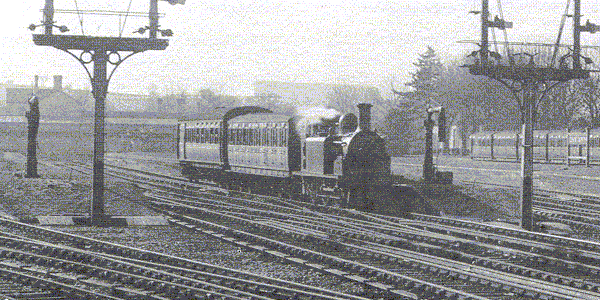
1928
branch train with D1 leaving Epsom Downs
(R.C. Riley Collection)
|
| |
| Racing days
brought an otherwise unseen variety of engines to the
branch: Marsh 4-4-2Ts, I3 4-4-2Ts, H 0-4-4T, E5 0-6-2T,
with Pullman service invariably being hauled by 4-4-2T
locomotives. |
| |
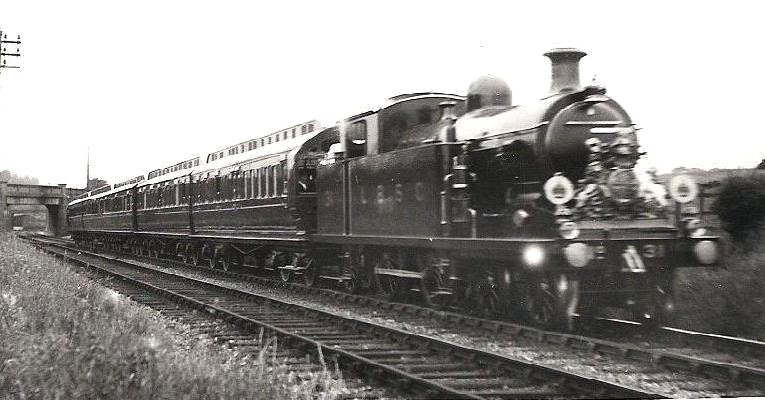
The
Royal Train pulled by Marsh I4 class locomotive no. 31
(12-40 departure from London Victoria to Epsom Downs)
has just left Belmont on 4 June 1913. This engine was
withdrawn in January 1936.
(NN, A.T. Wymann Collection)
|
| |
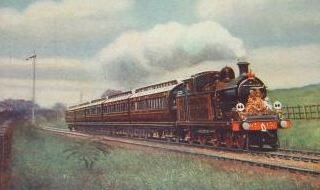 |
|
This photograph,
hand-coloured for the production as a postcard,
shows another Marsh I class 4-4-2T locomotive
(introduced in 1907/08), the standard LBSCR
choice for the Royal train to Epsom Downs (the
last of which ran to Epsom Downs in 1924). The caption
on the postcard reads "Royal train near
Banstead"; the towering signal on the
left is the "intermediate signal box C"
(in use only on racing days) and shows that the
train has only a few hundred yards to go before
it reaches Epsom Downs.
|
|
| |
| Following electrification of
the line in 1928, steam locomotive haulage was
limited to goods trains. Branch goods
trains were hauled by various E1 class
locomotives during the LBSCR period. The Southern
Railway used various 0-6-2T engines, such as
classes E3, E4, E4X, E6 and E6X. Initially out of
West Croydon shed, they later had their base at
Norwood Junction shed. During the British
Railways period, C2X 0-6-0s and subsequently
Moguls were used on freight traffic such as
domestic coal, gradually dropping off after 1964.
Following the demise of such
services to the stations along the line, steam
hauled trains became a rarity. In most cases,
such ventures onto the branch occurred as
specially chartered "railtour" events.
|
|
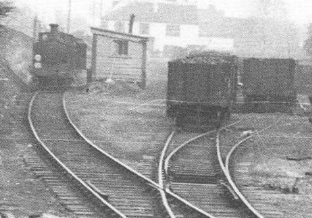
Belmont goods yard, c.1935
(Lens of Sutton)
|
|
| |
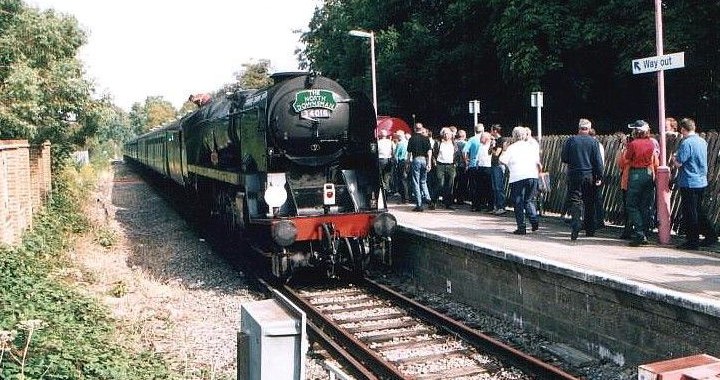
Steam returns to the branch in
September 2003 when Bulleid 'West Country' Pacific Bodmin
pays a railtour visit to Epsom Downs
(c)
John H. Bird
|
| |
| |
ELECTRIC
MULTIPLE UNITS (EMU)
|
|
| |
| Since the electrification of
the line in 1928, the electric multiple unit
(EMU) has reigned supreme - not surprising for
what has essentially been a commuter branch since
the 1920s. In the days of the
classic "Southern Electric", most
services were operated by SUB (suburban) EMUs.
After 1945, all-steel units
steadily started to replace the older
wooden-bodied stock.
In 1951, the first EPB
(Electro-Pneumatic Brakes) designs, direct
descendants of the SUB, were introduced.
These two and four car units
(2EPB and 4EPB, later designated Cl 416 and Cl
415) became the main motive power on the branch
throughout the 1960s and 1970s, and these
slam-door EMUs were only gradually replaced by
sliding-door stock (Cl 455) during the latter
half of the 1980s.
|
|
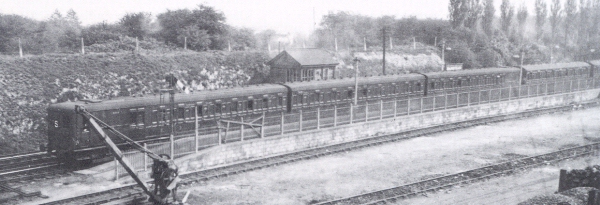
Two 3SUB sets with two
additional coaches in between on a Victoria to
Epsom Downs service at Banstead in 1938
(Lens of Sutton)
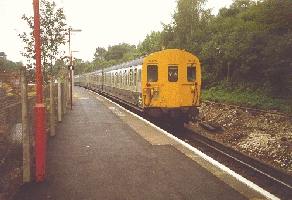 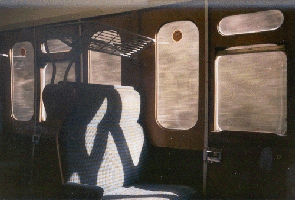
Cl 416 325 pulls into
Banstead in July 1987 with an Epsom Downs to
Victoria train
The interior of these slam-door units was
characterised by wooden panelling and soft seats
(Adrian Wymann)
|
|
| |
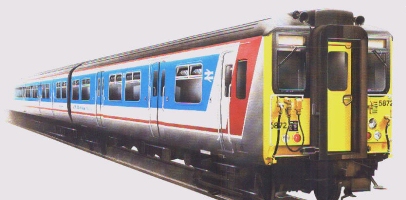
An artist's
impression of a Cl 455/8 to promote the NSE
livery
|
|
The Cl 455 EMUs were built in
three batches (455/8, 455/7 and 455/9). All were
formed as four car sets with two driving trailer
coaches, an intermediate trailer and a
non-driving motor coach which carried all the
traction equipment (four 250hp motors reclaimed
from 4-SUB units). The body shell was a shortened
version of the Mk.3 coach body.
The
Cl 455/8 were the first batch, delivered in 1982
to the Central and South Western divisions of BR
network.
|
|
| |
| During the
late 1980s, Network SouthEast gradually phased out the
EPBs on the branch and replaced them with Cl 455/8
multiple units. |
| |
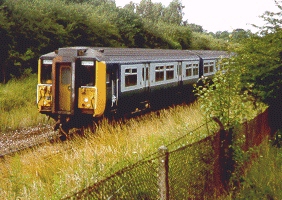 |
|
Since 1988,
the Cl 455/8 EMU works by far the largest part of
all services running onto the branch, and the
long reign of the Cl 455 on the Epsom Downs
Branch is reflected by the variety of liveries
seen on members of this multiple unit.
In July 1987, a British Rail
Blue & Grey liveried unit makes its way
across Banstead Downs en route from Belmont to
Banstead.
(Adrian Wymann)
|
| |
|
|
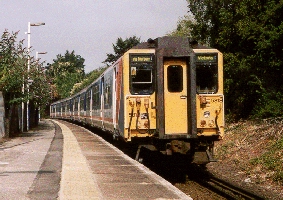 |
|
The
Network South East era is long gone by August
2000, but a Cl 455/8 glides into Banstead station
still wearing NSE "toothpaste" livery.
(Adrian Wymann)
|
| |
|
|
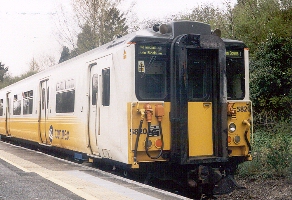 |
|
Cl 455 820 is about to depart
from Banstead on for the last lap of its journey
in April 2001, wearing the Connex SouthCentral
White & Yellow livery. (Adrian
Wymann)
|
|
| |
| The advent
of the Southern not only brought about a new livery, but
also also kicked off an extensive refurbishing programme
in 2004 for its fleet of Class 455 EMU units. |
| |
| After some two decades of
stalwart service they were in need not only of a
substantial overhaul but also of some corrections
to a number of interior design deficiencies
regarding e.g. seating layout or passenger
information and safety installations. Refurbisment
was undertaken at Eastleigh, with the most
noticeable exterior difference being the removal
of the end gangways, now plated over with a
central window. Unit numbers are now displayed in
full TOPS form in two groups of three digits
(e.g. 455 840), replacing the traditional four
digit unit designation (e.g. 5840). Furthermore,
a black box recorder and improved train
performance diagnostics are fitted.
|
|
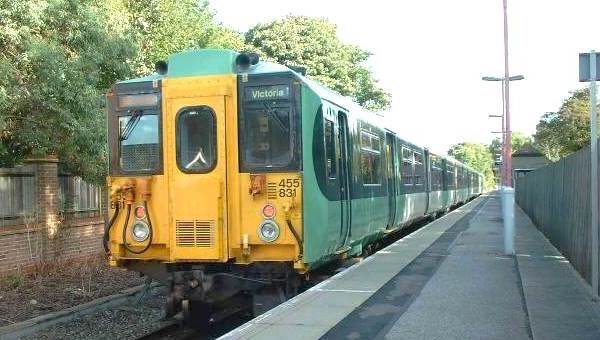
Refurbished Cl 455 831departs
Epsom Downs for London Victoria on 1 October 2005
(Adrian Wymann)
|
|
| |
| The first
refurbished unit, 455 828 entered service in March 2004,
the programme was completed by the end of 2005. |
| |
Cl 456 EMUs (built in 1990-91)
started to venture onto the line in the mid-1990s and
began appearing more and more often on the branch in the
following decade.
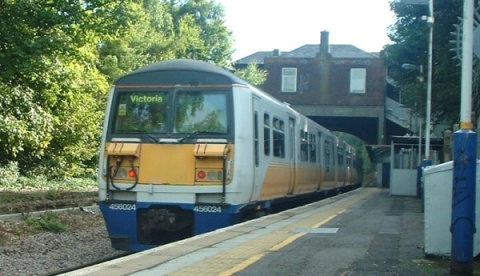
Cl
456 024 stands at Banstead with an off-peak London
Victoria service on 25 September 2005
(Adrian
Wymann)
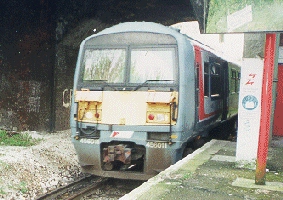 
Cl
456 arriving at Banstead in April 1995 (left,
Adrian Wymann) and departing Banstead with a
Victoria service in March 2002 (right,
Robert Oakes)
All
24 sets of Cl 456 EMUs were transfered to South West
Trains in 2013 following the arrival of new Cl 377 stock
to Southern that same year (Marsden, 2013).
|
| |
| |
LOCOMOTIVE
HAULED & MAINTENANCE
|
|
|
| |
| Since
electrification of the line in 1928, locomotive hauled
trains became a rarity on the branch and have only
occured in conjunction either with special trains (the
great British institution of the enthusiast's railtour
has made Epsom Downs a port of call since the 1950s) or
maintenance duties (such as the annual "water canon
train" usually to appear on the line in November in
order to wash away the accumulation of fallen leaves). |
| |
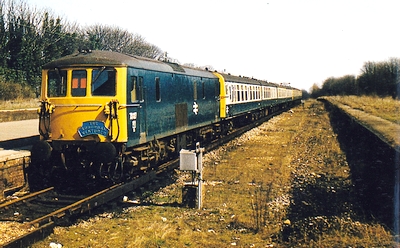 |
|
14
April 1979
Cl 73 127
"Suburban
Venturer" Railtour
Organised by the D.A.A.
Railtour Society, the "Suburban
Venturer" arrived at Epsom Downs shortly
after 11am and then headed back to Sutton a
quarter of an hour later. Class 73
Electro-Diesels have been occasional visitors
both to the old and new Epsom Downs stations on
railtour duties.
(Alan Austin)
|
|
| |
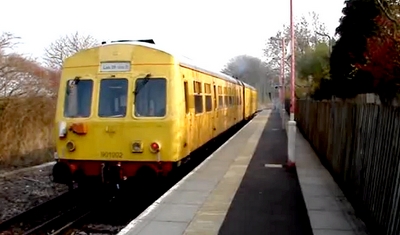 |
|
28 March 2007
Cl
901 002
Converted
in 1991 from a Cl 101 DMU for
departmental use, 901 002 was rebuilt by
BR's Research & Development Division
as a test train also known as Iris II.
It travelled on the Epsom Downs
branch in late March 2007 doing track
video survey work for its owner Network
Rail.
(James Wray)
|
|
|
| |
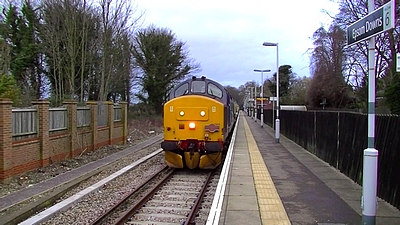 |
|
25 January
2014
Cl
37 610
"Buffer
Puffer 11.0" Railtour
Regularly
organised by Pathfinder Railtours,
previous "Buffer Puffer"
excursions had already called at Epsom
Downs with Cl 73 and Cl 33 locomotives,
but January 2014 saw a total stranger
call for a stop in the form of Cl 37 610
(Cl 37 405 was at the tail end).
(Bob
Faulkner)
|
|
|
| |
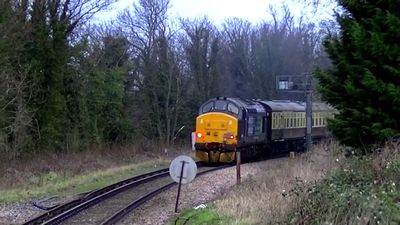 |
|
25 January
2014
Cl
37 610
"Buffer
Puffer 11.0" Railtour
Heading back
to Sutton, Cl 37 610 is pictured pushing
the tour's consist of Mk I coaches around
the bend leading in (or in this case out)
of Epsom Downs station.
(Bob
Faulkner)
|
|
|
| |
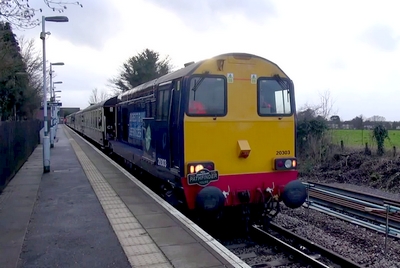 |
|
8 February
2014
Cl
20 303
"Buffer
Puffer 11.1" Railtour
Only a
fortnight later Pathfinder Railtours were
back on the branch, this time with the
"Buffer Puffer 11.1" which took
Cl 20 303 and Cl 20 304 for a run over
the branch.
(Bob
Faulkner)
|
|
|
| |
|